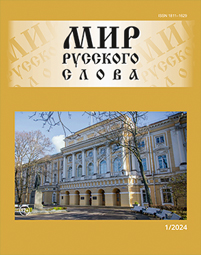Multimedia Educational Complex “Pushkin on the Interactive Reading Lesson”: Methodology, Structure and Possibilities of Use
DOI:
https://doi.org/10.21638/spbu30.2024.110Abstract
The article presents a new project of the Pushkin Institute “Creation of a multimedia educational complex ‘Pushkin on an interactive reading lesson’ ” made for the anniversary of the great poet with the financial (grant) support of the “Russian World” Foundation. The author’s methodology of teaching fiction reading used in the project is described, according to which more than 60 online reading lessons have already been created, posted on the website of the course “Reading Lessons, a holiday that is always with you”, and at least 200 scenarios of face-to face reading lessons, as well as corrections that were made during the creation process the jubilee Pushkin project. Th ese corrections concerned the methodological preparation of a literary text for educational activities (dividing the text into parts and creating four lessons) and the organization of work with linguistic and cultural objects. The article contains a detailed overview of the structure of the multimedia complex, which includes the following components: a cycle of four online text reading lessons according to the text of the story by Pushkin “The Squire’s Daughter” in the versions “For Readers and Teachers” (8 lessons in total), four offline reading lessons (in the format of mobile applications) and additional resources to them (pdf application with creative tasks and a mobile application with a filword, as well as the text of the story in three formats — video, audio and pdf. All components of the multimedia complex are available on the illustrated website of the project, which in turn does not just serve as a place to place all the components of the complex, but performs a meaningful role, creating a special atmosphere, immersing the reader in the magical Pushkin world. In the final part of the article, the target groups of potential users of the project are indicated, as well as various possibilities for using the multimedia project in educational activities are proposed.
Keywords:
Alexander Pushkin, digital educational environment, multimedia, semantic perception of text, interactive reading lesson
Downloads
References
Downloads
Published
How to Cite
Issue
Section
License
Articles of "The World of Russian Word" are open access distributed under the terms of the License Agreement with Saint Petersburg State University, which permits to the authors unrestricted distribution and self-archiving free of charge.




